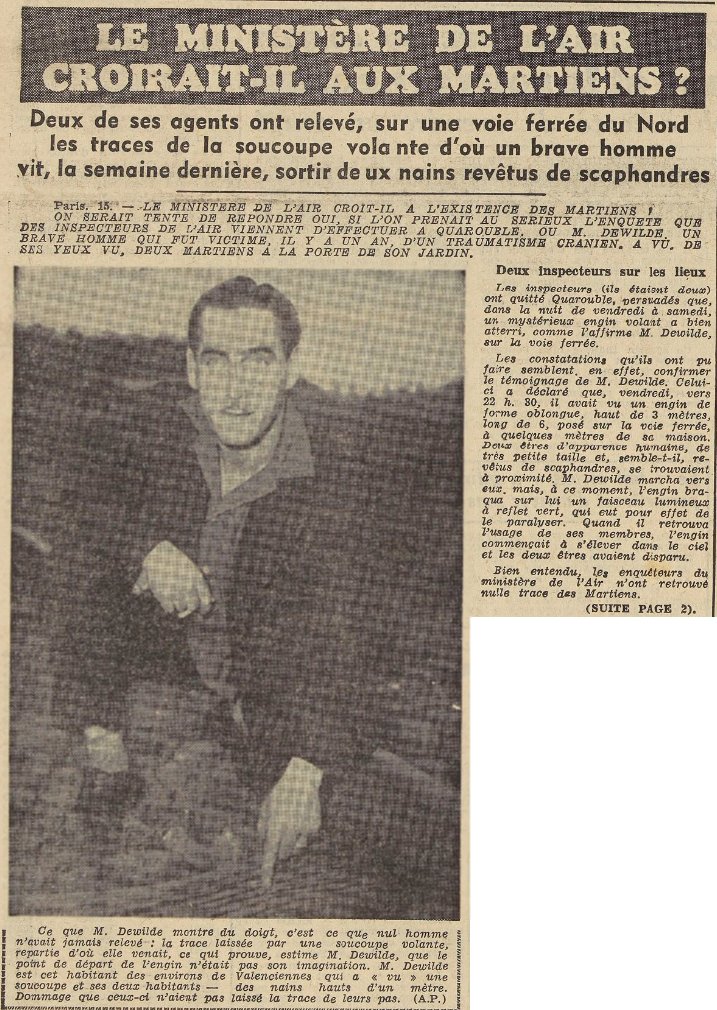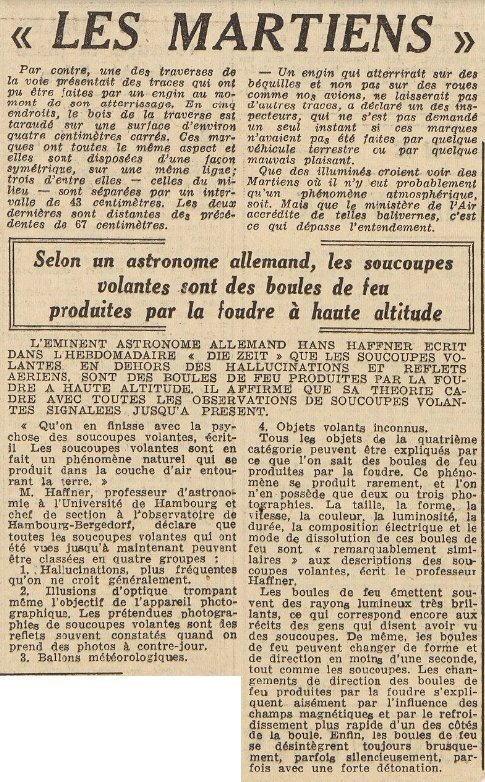The article below was published in the daily newspaper Le Télégramme de Brest et de l'Ouest, Brest, France, page 2, on September 16, 1954.

|
Paris, 18. -- DOES THE AIR MINISTRY BELIEVE IN THE EXISTENCE OF MARTIANS? ONE MIGHT BE TEMPTED TO ANSWER YES, IF ONE WERE TO TAKE SERIOUSLY THE INVESTIGATION JUST CONDUCTED BY AIR INSPECTORS IN QUAROUBLE, WHERE MR. DEWILDE, A GOOD MAN WHO, A YEAR AGO, SUFFERED A CRANIAL TRAUMA, CLAIMS TO HAVE SEEN - WITH HIS OWN EYES - TWO MARTIANS AT THE GATE OF HIS GARDEN.
Two inspectors on the scene
The inspectors (there were two) left Quarouble convinced that, on the night of Friday to Saturday, a mysterious flying craft did in fact land, as Mr. Dewilde claims, on the railway track.
The findings they were able to make do seem to confirm Mr. Dewilde's testimony. He stated that, on Friday around 10:30 p.m., he saw an oblong-shaped craft, 3 meters high and 6 meters long, positioned on the railway track just a few meters from his house. Two beings of human appearance, very small in stature and apparently dressed in diving suits, stood nearby. Mr. Dewilde walked toward them, but at that moment, the craft shone a greenish light beam on him, which had the effect of paralyzing him. When he regained control of his limbs, the craft was starting to rise into the sky, and the two beings had vanished.
Of course, the investigators from the Air Ministry found no trace of the Martians.
(CONTINUED ON PAGE 2).

|
On the other hand, one of the railway ties showed marks that could have been made by a craft during landing. In five places, the wood of the tie is indented over an area of about four square centimeters. These marks all have the same appearance and are arranged symmetrically, in a straight line; three of them - the ones in the middle - are spaced 43 centimeters apart. The remaining two are 67 centimeters away from the previous ones.
"A craft landing on struts rather than wheels, like our airplanes, would not leave any other traces," declared one of the inspectors, who didn't for a moment consider whether these marks might have been made by some terrestrial vehicle or a prankster.
That some dreamers believe they see Martians where there was probably just an atmospheric phenomenon - fine. But that the Air Ministry gives credence to such nonsense is beyond comprehension.
THE EMINENT GERMAN ASTRONOMER HANS HAFFNER WRITES IN THE WEEKLY "DIE ZEIT" THAT FLYING SAUCERS, APART FROM HALLUCINATIONS AND AERIAL REFLECTIONS, ARE FIREBALLS PRODUCED BY HIGH-ALTITUDE LIGHTNING. HE ASSERTS THAT HIS THEORY MATCHES ALL REPORTED FLYING SAUCER SIGHTINGS TO DATE.
"Let's put an end to the flying saucer psychosis," he writes. "Flying saucers are, in fact, a natural phenomenon that occurs in the layer of air surrounding the Earth."
Mr. Haffner, professor of astronomy at the University of Hamburg and section head at the Hamburg-Bergedorf Observatory, states that all flying saucers seen so far can be classified into four groups:
1. Hallucinations, more frequent than generally believed.
2. Optical illusions that can even deceive a camera lens. The so-called photographs of flying saucers are often reflections seen when taking pictures against the light.
3. Weather balloons.
4. Unknown flying objects.
All the objects in the fourth category can be explained by what is known about fireballs produced by lightning. This phenomenon is rare, and only two or three photographs of it exist. The size, shape, speed, color, brightness, duration, electric composition, and mode of dissolution of these fireballs are "remarkably similar" to descriptions of flying saucers, writes Professor Haffner.
Fireballs often emit very bright beams of light, which also corresponds to the accounts of people who say they saw saucers. Likewise, fireballs can change shape and direction in less than a second, just like saucers. The directional changes of fireballs produced by lightning can easily be explained by the influence of magnetic fields and by one side of the ball cooling faster than the other. Finally, fireballs always disintegrate abruptly - sometimes silently, sometimes with a loud bang.